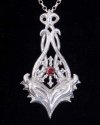… If you want to be a “folk artist“,… then just carve the knife out of wood, paint it and glue a bunch of cheap rhinestones on.
Hmm...
The BladeForums.com 2024 Traditional Knife is available! Price is $250 ea (shipped within CONUS).
Order here: https://www.bladeforums.com/help/2024-traditional/
… If you want to be a “folk artist“,… then just carve the knife out of wood, paint it and glue a bunch of cheap rhinestones on.
Let's just say Tai and I have a difference of opinion about folk art and leave it at that.
Always work silver cold.-Page

Page, I don't see your point. 20 gage IS thin no matter how much hiegth/debth there is to the repousse,... which is usually done in a pitch pot and can't be hot anyway. It's thin and probably done in pitch.
You said, "Always work silver cold.",... which is just flat out wrong.
Nice pendant though.
ignore what Tai just said -Page
